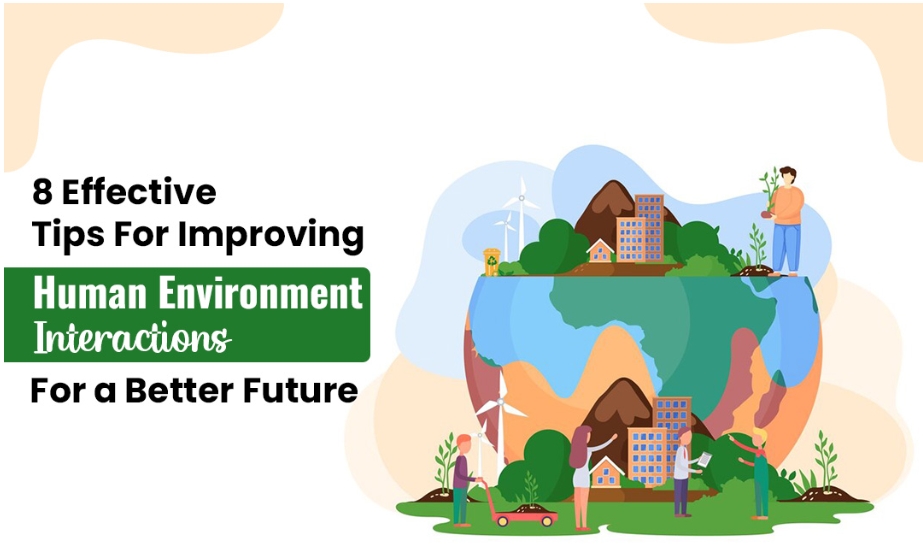
Earth’s diversity helps humans maintain a healthy and quality lifestyle. It provides basic things that we need to survive, ranging from food to water. But what are humans doing to serve Earth? Human activities are causing rapid environmental changes that make this planet less sustainable.
According to the Nature Conservancy, the average carbon footprint of a person is 4 tons, which goes up to 16 tons in developed countries such as the U.S. There is no way to avoid this effect; however, there are some ways to lessen it to improve human-environment interactions. Here, we’ll share some tips that can help us improve this interaction.
Let’s get started with exploring the meaning of human-environmental interaction.
What Is the Meaning of Human Environment Interaction?
The term human-environment interactions showcase a connection or relations between humans’ social activities and our ecosystem. In simple words, it can be defined as how humans interact with the natural environment to meet their needs and the consequences of our activities on the natural environment.
There are two types of human-environmental interaction: positive and negative. Positive interaction includes upcycling and recycling, while deforestation or recycling refers to the negative. Unfortunately, nowadays, negative human-environmental interactions outweigh the positive ones.
Due to the adverse effects of human activities on our natural environment, most environmental science students prefer to opt for this topic during their coursework. They are eager to know how human actions can bring changes in our natural climate. They also get coursework writing assistance from their teachers, seniors, or professionals to understand this crucial topic.
8 Effective Ways to Improve Human Environment Interaction
Human-environment interaction is a complex dynamic between humans and the natural environment. Due to human activities, the ratio of negative interaction has been increasing nowadays.
Some effective tips need to be followed to lessen this negative impact that we are going to mention in this section. Continue to read to check the important points of this article.
Important Points to Remember:
- Humans interact with the environment in two ways: positively and negatively.
- Negative human-environment interaction outweighs the positive.
- To overcome these negative impacts, we must follow some tips.
- These tips include adapting to recycling, starting to reduce our waste, using renewable energy sources, minimising the use of chemicals, saving water resources, and using sustainable transportation.
1. Recycling and Sorting
With the introduction of plastic, there is mass production of this material, which ultimately leads to huge plastic wastage. You can follow some effective remedies for this problem. One of the most effective ways is to recycle plastic. This process involves recycling waste material instead of producing new material from the raw material. This practice will lessen the wastage and avoid pollution that may be created during the extraction of raw material.
In addition, in most developed countries, a sorting system has been introduced that makes recycling easier. With this system, waste material is sorted effectively so that the recycling materials process the waste smoothly. Consequently, less material waste in landfills is less harmful to the environment.
2. Wasting Less
The less you waste, the more you improve human-environment interactions. Recycling and reusing automatically reduce the need for deforestation, mining, and drilling. Simply put, when you reuse material, carbon-emitted factories don’t need to produce material, which ultimately lowers carbon footprints.
Businesses that produce large amounts of waste need to follow the below steps to lessen their impact on human-environmental interaction.
- Use repurposed equipment, such as refurbished electronic devices.
- Always invest in devices with long lives. Although these devices are expensive, they are like long-term investments.
- Educate your employees to minimise the waste by reusing and recycling the equipment.
3. Planting More Trees
The rapid deforestation in recent years is one of the prime reasons for negative human-environment interactions. This deforestation brings abrupt climate changes and turns the earth into a heated island. Planting more trees can alleviate these changes as greenery and other flora avoid overheating. It is the most simple and easy tip for better interaction between humans and the environment. Undoubtedly, this small change can make a big difference.
You just have to grab some seeds and start planting today, as no one saw tomorrow. Trees absorb tons of CO2 and emit oxygen. Just make sure that you have planted the right trees in the right place. Planting the trees in the wrong place can negatively impact the ecosystem and can cause wildfires.
4. Use Better Alternatives
The most important thing is our concerns related to the impacts of our activities on the environment. Just finding ways to tackle the current environmental issue is itself a positive human impact on the environment. Large businesses can search for technological alternatives to reduce the negative impact of their environmental practices.
One way to achieve sustainable goals is to get B Corp certification. This certification proves that the company is meeting the highest environmental regulations. Moreover, this initiative also helps companies discover what actions they need to take to qualify for this certification. In a nutshell, this type of alternative encourages businesses or even individuals to find environment-friendly solutions.
5. Use Renewable Sources
The negative impacts of non-renewable energy sources on our environment cannot be overstated. Emitted carbon from these energy sources is the prime reason for global warming. To overcome these adverse effects, we are now moving on to the usage of sustainable energy sources.
One of the greatest benefits of the energy generated from these sources is that it is emission-free, which makes our environment safe. Carbon emissions can even destroy our ecosystem. The most popular sustainable energy source is the energy obtained by the sun, which is affordable and easily available. Most businesses are now shifting to this energy source.
6. Minimise the Use of Chemicals
One of the major reasons for negative human-environment interactions is the use of chemicals. We use various chemicals in our daily lives, from cleaning detergents to body sprays. These chemicals seep into our natural environment and poison it. The best thing is that none of these chemicals is necessary at all. Various non-profit environmental working groups have provided a consumer guide that encompasses safe alternatives to these chemicals.
Additionally, the most harmful chemicals are the pesticide sprays humans use in their lawns, and the chemicals factories produce during their manufacturing process. If humans only avoid the use of these two chemicals, then they can make a significant contribution to reducing their negative impacts on the environment.
7. Save Water
Water is an essential element of our environment and plays a key role in maintaining its diversity. On Earth, life is only possible due to water and oxygen; our planet is made of 97% salted water. Although salted water is not good for humans, only 3% of freshwater is used for drinking. But this water is being wasted more rigorously than what we drink.
Sadly, it is true that the water is wasted more frequently than we see. If it continues to waste then soon our water resources runoff. It is time to change our bad habits and spread awareness about the importance of water.
8. Use Sustainable Transportation
Our transportation is the prime source of carbon emissions that eventually contribute to climate change. Therefore, if you want to reduce negative human-environment interactions, you must use electric vehicles or follow some tips when travelling. You must also travel by public transport as much as possible to lessen your carbon footprint.
Moreover, if you are planning to buy a new car, opt for an electric car. If you are a student, use college transport. These small practices can help you reduce your carbon footprint. Due to the importance of these small practices, teachers include tips for better human-environment interactions in college coursework to spread awareness among students. Top-notch coursework writing platforms in the UK can help students cover this topic so they can contribute to this Save Planet initiative.
Conclusion
Human activities can positively and negatively impact the natural environment. Understanding human-environment interactions is imperative to maintaining a quality life. There are two types of interactions: positive and negative. Unfortunately, these days, negative impacts outweigh positive impacts.
Therefore, in this article, we have shared some effective tips that can help to lessen these negative impacts. These tips include implementing reusing and recycling, wasting less, using alternatives, minimising chemical use, saving water, and using sustainable transportation. Start implementing these tips from today to make the Earth a safe planet.



